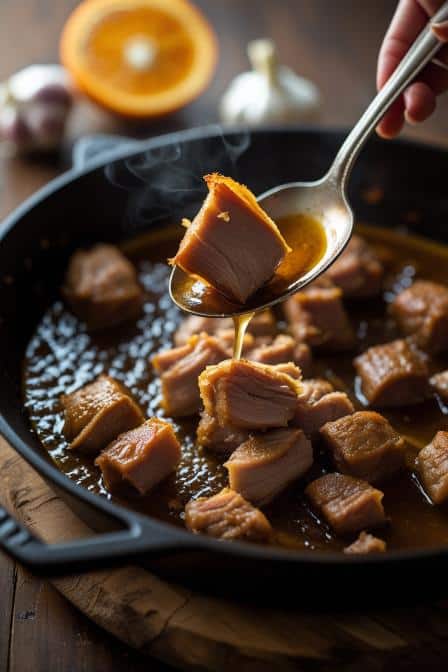You ever bite into something so tender it nearly falls apart before your teeth even show up for duty? That’s carnitas done right. Not overcooked. Not dry. Just glistening, rich, porky perfection—crispy on the edges, soft in the middle, like it’s been marinated in the gods’ pantry.
I still remember the first time I had proper carnitas—not the stuff they shovel out at chain taco joints with neon salsa, but the kind that came outta an old copper pot somewhere outside Michoacán, nestled in a dusty roadside stall. I was halfway through the taco before I realized I’d gone silent. That’s when you know it’s real.
Carnitas, which literally means “little meats” in Spanish, is Mexico’s answer to slow-cooked pork glory. It’s a dish steeped in heritage and technique. At its core? Pork slowly braised in its own fat until meltingly tender, then cranked up in heat for those irresistible crispy bits.
And trust me, you don’t need a copper cauldron from a Mexican abuela to get it right at home (though, I mean, that’d help).
What Are Traditional Carnitas?
Carnitas are a traditional Mexican pork dish made by simmering large cuts of pork in lard—yes, actual pig fat—until the meat is so tender it practically begs to be shredded. It’s then crisped up to develop a golden-brown crust, offering a textural contrast that’s nothing short of addictive.
Unlike pulled pork or other slow-cooked meat dishes, carnitas are all about that combo of melting softness with a caramelized finish. They’re typically made with pork shoulder or butt, both well-marbled and strong enough to hold up to hours of heat.
And there’s beauty in the simplicity. No smoke, no woodchips, no sugar-laced rubs. Just time, fat, salt, and a few quiet aromatics.
Ingredients & Substitutions
Here’s the thing—ingredients matter, but there’s room to tweak without breaking the soul of the dish.
Core Ingredients Table
| Ingredient | Purpose | Substitutions & Notes |
|---|---|---|
| Pork shoulder (bone-in or boneless) | Fatty and flavorful cut ideal for slow braising | Pork butt, pork picnic roast (avoid lean cuts like loin) |
| Lard | Traditional fat for confit-style cooking | Duck fat, vegetable shortening, or high-smoke point oils |
| Orange (halved) | Adds a subtle citrus brightness | Lime or grapefruit in a pinch, but orange is ideal |
| Onion (quartered) | Aromatics, sweetness | Shallots or white onion work too |
| Garlic cloves | Aromatics, earthy base flavor | Garlic powder if fresh isn’t available (not recommended) |
| Bay leaves | Background herb note | Oregano (dried) or thyme (but use sparingly) |
| Salt | Flavor foundation | Sea salt or kosher—avoid iodized |
| Mexican Coca-Cola (optional) | Adds subtle sweetness and caramelization | Brown sugar + water combo if Coke not available |
| Milk (optional) | Helps caramelize and tenderize | Adds richness—can be skipped, but improves browning |
Choose pork shoulder with plenty of fat—lean meat just won’t cut it. And yes, lard makes a difference. If you’re squeamish, try duck fat. But no dry olive oil tricks here, please.
Step-by-Step Instructions
Cooking carnitas is less about skill and more about patience. Still, there are moments where it can all go sideways if you’re not paying attention.
Step 1: Prep the Pork
Cut your pork shoulder into large chunks—about the size of a plum or a small fist. Don’t go tiny. You want big pieces to slow-cook properly.
Expert Tip: Leave the fat cap on. That’s where the magic hides. Trim too much fat, and your carnitas might turn out dry like Sunday leftovers.
Step 2: Arrange in Dutch Oven
Place the pork in a wide, heavy-bottomed pot or Dutch oven. Nestle in the garlic, onions, bay leaves, and orange halves (cut-side down). Pour in just enough lard or fat to cover the meat.
Mistake to Avoid: Don’t overcrowd the pan. Overpacking means uneven cooking. Give it some elbow room.
Step 3: Slow Simmer (2.5 to 3 hours)
Set the heat to low. Let the pork simmer—not boil—in the fat for a few hours. You’re not looking for bubbling chaos, just a lazy simmer.
Why It Matters: High heat can toughen the meat and ruin texture. This is confit-style, not a hot tub party.
Optional at this stage: pour in a splash of Mexican Coke or a bit of milk. Both will enhance flavor depth and help with that final browning.
Step 4: Shred & Crisp
Once fork-tender, remove the pork with a slotted spoon. Shred roughly—don’t pulverize. Toss onto a baking sheet or back into a dry skillet for a quick crisping session.
Pro Tip: Broil it for 5–7 minutes or pan-fry until edges brown and crackle.
Wanna make it spicy? Toss some chipotle adobo sauce or crushed chili flakes into the skillet.
Cooking Techniques & Science
Traditional carnitas is slow pork confit. You’re basically cooking the pork in its own rendered fat at a low temp until it’s absurdly tender.
Why confit? This ancient technique lets the meat cook gently without drying out. Fat becomes both the cooking medium and a flavor vault.
The final step—the crisp—is a Maillard reaction playground. High heat on cooked protein causes the outer layers to brown and caramelize. That’s flavor you can’t mimic with shortcuts.
Tools That Matter
- Dutch Oven or Cast-Iron Pot: Retains steady low heat and has enough width to prevent crowding.
- Slotted Spoon: Lets you pull meat without carrying excess fat.
- Sheet Pan or Skillet: For crisping. Don’t skip this. It’s where the magic finishes.
How to Store & Reheat Carnitas
Storage: Keep in an airtight container submerged in some leftover fat. That fat acts like a natural preservative.
Fridge Life: Up to 5 days
Freezer Life: 2–3 months (wrap tightly, then bag)
Reheat: Best method? Re-crisp in a skillet or under a broiler. Microwave works, but you’ll lose texture. Avoid it if possible.
Variations & Substitutions
- Spicy Carnitas: Add jalapeños, chili flakes, or chipotle peppers.
- Citrus Twist: Try lime and grapefruit for a tangier base.
- Vegan Version: Okay… let’s be honest. “Vegan carnitas” is a lie, but jackfruit or oyster mushrooms cooked with similar flavors can imitate the texture.
Serving & Pairing Suggestions
Carnitas go with anything. But they shine when they’re the hero.
- Classic Tacos: Warm corn tortillas, chopped onion, cilantro, lime.
- Torta: Crusty Mexican roll + avocado + carnitas = bliss.
- Carnitas Nachos: Yep. Add crema, pickled jalapeños, and queso fresco.
Drinks: Pair with a smoky mezcal, Mexican lager, or even agua de tamarindo.
Sides: Charro beans, esquites (Mexican street corn), or a simple avocado salad.
And if you’re feeling fancy, make a carnitas hash with crispy potatoes and fried eggs. Breakfast of legends.
Best Time to Serve or Eat This Dish
Honestly? Anytime. Carnitas ain’t shy.
But they hit best at gatherings—Sunday family dinners, backyard parties, or holiday feasts. They hold well, feed many, and feel special without trying too hard.
Late night? Perfect. Hungover brunch? Even better.
Conclusion
Carnitas aren’t just pork. They’re a technique, a tradition, a celebration of texture and patience. They’re about the slow simmer, the crackling finish, and that first tender bite that makes you shut your eyes for a sec.
If there’s one thing I’ve learned in years of cheffing and chasing flavor—it’s that carnitas don’t need fancy tricks. They just need time, good fat, and respect for the method.
So don’t rush it. Don’t skip the crisp. And whatever you do, don’t drain the flavor away.
FAQs
What cut of pork is best for carnitas?
Pork shoulder or pork butt. They have the right balance of fat and connective tissue, which breaks down beautifully during slow cooking.
Can I make carnitas without lard?
You can, but it won’t be the same. Duck fat or a neutral oil with high smoke point can work. Just don’t expect that same rich mouthfeel.
Are carnitas gluten-free?
Yep! As long as you’re not tossing them into flour tortillas or adding any wheat-based sauces, they’re naturally gluten-free.
Can I use a slow cooker or Instant Pot?
Yes. Use the slow cook setting to confit, then crisp separately in the oven or skillet. Instant Pot can speed things up, but go slow if you want depth.
What’s the difference between carnitas and pulled pork?
Pulled pork is usually smoked or cooked with sweet barbecue sauces. Carnitas is slow-cooked in fat and finished with a crisp. Completely different flavor and texture profile.
If you make these right, you’ll never look at pork the same way again.

